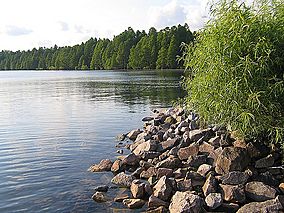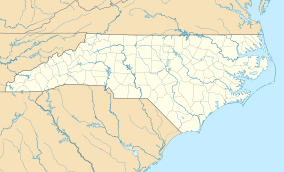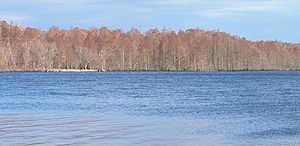Pettigrew State Park facts for kids
Quick facts for kids Pettigrew State Park |
|
|---|---|
|
IUCN Category III (Natural Monument)
|
|

A view of Lake Phelps at Pettigrew State Park
|
|
| Location | North Carolina, United States |
| Area | 5,951 acres (24.08 km2) |
| Elevation | 10 ft (3.0 m) |
| Established | 1939 |
| Named for | J. Johnston Pettigrew |
| Governing body | North Carolina Division of Parks and Recreation |
Pettigrew State Park is a state park in North Carolina, United States. It covers about 5,951 acres (24.08 km2) of land. The park is located in Tyrrell and Washington Counties. It sits along the shores of Lake Phelps and the Scuppernong River.
You can find the park's main areas south of U.S. Route 64. These are near the towns of Roper and Creswell. Pettigrew State Park is open all year for fun activities. These include hiking, camping, fishing, boating, and picnicking.
The park is named after J. Johnston Pettigrew. He was a Confederate General who lived nearby. The park also surrounds Somerset Place. This is a historic site with a restored 1830s plantation house. You can tour the house and other buildings, including reconstructed slave quarters.
Pettigrew State Park was created during the Great Depression. The land was leased from the Farm Security Administration. This was a program started by U.S. President Franklin D. Roosevelt.
Part of the park is around Lake Phelps. This is one of the oldest lakes in the eastern United States. Long ago, it was a hunting and fishing spot for the Algonquian peoples. Scientists have found ancient dugout canoes in the lake. Some are up to 4,400 years old! They were kept safe by the lake's super clean water.
Pettigrew State Park is full of amazing wildlife. Lake Phelps is a key winter home for many waterfowl. These include Canada geese and Tundra swans. You can also see woodland animals like raccoons and white-tailed deer. These are common along the East Coast. Lake Phelps also has many fish, such as largemouth bass and catfish.
The park also looks after Lake Phelps itself. The lake is about 16,600-acre (67 km2) and is a North Carolina State Lake. In total, the park manages about 22,430 acres (90.8 km2) of land and water.
Contents
Park History
Ancient Lake and First People
Pettigrew State Park surrounds Lake Phelps. This is North Carolina's second largest natural lake. The lake is on a piece of land between Albemarle Sound and the Pamlico River. It is one of many "Carolina bay" lakes. These lakes stretch from New Jersey to Florida.
No one knows exactly how these lakes were formed. Lake Phelps gets its water only from rain and underground springs. No streams flow into it. This means the water stays very clean. Lake Phelps is about 5 miles (8 km) wide. It is only about 4.5 feet (1.5 m) deep on average. Scientists think the lake is over 38,000 years old.
Lake Phelps is named after Josiah Phelps. He was the first European-descended person to enter its waters. In 1755, Phelps and another explorer, Benjamin Tarkington, were looking for animals to hunt and farmland. They were about to give up when Tarkington climbed a tree. He saw the lake nearby! Phelps ran into the water first. So, he got to name the lake.
People have lived around Pettigrew State Park for a very long time. Evidence shows people were here as far back as 8000 BC. Scientists have found thousands of old items in the park. These include pottery, arrowheads, and sunken dugout canoes. Some of these canoes are at least 4,400 years old. The lake's clean water kept them safe at the bottom.
The Algonquian peoples made these canoes. They visited the area during certain seasons. They made canoes from cypress logs. They would slowly burn out the middle of the log. Then they scraped out the burnt wood. This left only the outer shell. Historians believe the Algonquian people would sink their canoes. This kept them safe until they came back for the next fishing and hunting season. Thirty of these old canoes have been found in Lake Phelps. There might be more waiting to be discovered!
Plantation Life and General Pettigrew
Josiah Collins was one of the first European settlers to farm near Pettigrew State Park. He arrived in the 1780s. Collins and his partners used the labor of enslaved people. They drained the swamps around Lake Phelps. This created a large plantation called Somerset Place.
Enslaved people from Africa were forced to dig a canal. This canal connected Lake Phelps to the Scuppernong River. The canal had two main uses. First, it moved goods and people to and from the plantation. Second, it was a huge drainage ditch. The enslaved people at Somerset Place worked hard to drain the swamps. Later, more canals were built. These canals helped bring water to the rice and corn fields.
Pettigrew State Park is named for J. Johnston Pettigrew. He was a Confederate General. He is buried in the family cemetery within the park. General Pettigrew was a leader at the Battle of Gettysburg. He was badly hurt during General Robert E. Lee's retreat from Gettysburg. He grew up on a farm next to Somerset Place. His burial site is a popular spot for park visitors.
Somerset Place was a successful plantation. But the American Civil War changed everything. After the war, enslaved people were freed. The Collins family could not keep the plantation running without their forced labor. So, they sold it.
Becoming a State Park
Somerset Place and the land that is now Pettigrew State Park changed owners many times. In 1937, the Farm Security Administration bought it. This was during the Great Depression. In 1939, the state of North Carolina leased the land for 99 years. This lease was with the United States Department of Agriculture.
Pettigrew State Park has grown bigger over the years. Two recent additions were the entire shoreline of Lake Phelps. The biggest expansion happened in 2004. This added land along the Scuppernong River.
The Scuppernong River stayed mostly wild for a long time. In 1793, the town of Columbia was built on its banks. The Scuppernong is a "blackwater river." Its water looks like black tea or coffee. The river was important for travel for early settlers. Since 1989, the Nature Conservancy has worked to protect the river. In 2002, they offered to give four pieces of land along the Scuppernong to the state. The state agreed to buy three more pieces that became available. In 2004, this area was officially added to the state park system.
Park Ecology: Plants and Animals
Amazing Plant Life
Pettigrew State Park has one of the last remaining old-growth forests in eastern North Carolina. An old-growth forest means the trees are very old and have not been cut down much. You can find bay trees, sweetgum, pawpaw, persimmon, bald cypress, and poplar trees here. These are on the northern shore of Lake Phelps. Some cypress trees have trunks up to ten feet (3 m) wide! The poplar trees can have trunks six feet (2 m) wide. There are also vines as thick as a person's leg. They grow up the trees over 130 feet (40 m) high.
Along the Scuppernong River, you can see Atlantic white cedar trees. These and other rare cedars have grown very large. Several trees at Pettigrew State Park are listed on the North Carolina and National Registries of Big Trees. This means they are some of the biggest trees of their kind.
You can find many Wildflowers throughout Pettigrew State Park. Look for Atamasco lily, periwinkle, buttercup, Jack-in-the-pulpit, maypops, and jewelweed. These are sometimes found near Lake Phelps. The Scuppernong River is home to swamp dogwood, evening primrose, blue flag iris, and cardinal flowers. The roughleaf dogwood is also near the river. This type of dogwood is rare in North Carolina.
Wonderful Animal Life
Lake Phelps and the Scuppernong River attract many different waterfowl. Lake Phelps is one of several large, shallow freshwater lakes. These lakes are winter homes for ducks, geese, and swans. The waterfowl at Lake Phelps mostly rest here. Then they fly to nearby places to find food. Tundra swans and Canada geese eat in nearby farm fields. Ducks find food in the wetlands. These birds usually arrive in October and stay until February or March. Common waterfowl you might see include Canada geese, tundra swans, mallards, American black ducks, and northern pintails.
Pettigrew State Park is also home to several birds of prey. Ospreys build their nests in the tallest trees. They eat the many fish from Lake Phelps. The number of bald eagles is growing, and you might spot them flying over the park. At least three kinds of owl live in the park's forests: the great horned owl, barred owl, and eastern screech owl. You can also see red-tailed and red-shouldered hawks. American kestrels and northern harriers also live here.
Wading birds and woodland birds live in Pettigrew State Park all year. The shores of Lake Phelps and the Scuppernong River offer lots of hiding places and food. These are great for sandpipers, great blue herons, great egrets, and green herons. The woods are home to bobwhites, pileated woodpeckers, woodcocks, red-cockaded woodpeckers, and mourning doves. Songbirds in the park include prairie and prothonotary warblers, common yellowthroats, and northern parulas.
Pettigrew State Park also provides homes for eastern woodland mammals. Black bears and white-tailed deer live in the woods. You might also see Virginia opossums, raccoons, American minks, muskrats, North American river otters, foxes, and bobcats. The endangered red wolf has been brought back to eastern North Carolina, including Pettigrew State Park.
The most common fish in Lake Phelps are largemouth bass, chain pickerel, catfish, yellow perch, and pumpkinseed. These fish are what first drew the Algonquian peoples to this area thousands of years ago.
Fun Activities at the Park
Pettigrew State Park is open all year for fun! You can go hiking, fishing, camping, boating, and picnicking.
Lake Phelps is great for canoes, kayaks, rowboats, and boats with engines. You can launch your boat at Cypress Point or behind the park offices on Lake Shore Drive. There's even a canoe trail in the old canals. These canals were built by enslaved people during the plantation era. The Scuppernong River is also open for most types of boats.
The main campground is in a cypress and sweetgum forest. It has 13 campsites for tents or camping trailers. Each site has a picnic table and a charcoal grill. There's another campsite in a grassy field with the same things. A large group camping area is in the forest. It has tent pads, grills, and simple toilet facilities. All campers can use a central bathhouse with flush toilets and showers.
Both Lake Phelps and the Scuppernong River are open for fishing. The North Carolina Wildlife Resources Commission (NCWRC) has rules for fishing. These rules help keep the fish populations healthy. For example, anglers can keep largemouth bass that are longer than 20 inches (50.8 cm) or between 14 and 16 inches (35.6-40.6 cm). This rule helps grow more "trophy fish" (fish over 20 inches). The NCWRC also stocks Lake Phelps with bluegill. They have also started a program to bring back alewife and blueback herring using a special "fish ladder" on Bee Tree Canal from the Scuppernong River.
Pettigrew State Park has three pavilions and one large picnic area. You can use these on a first-come, first-served basis. There are three hiking trails. They go along the shore of Lake Phelps and wind through the woods.






